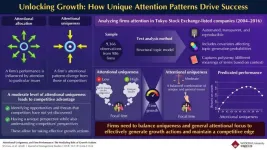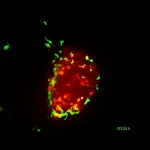(Press-News.org) Experts provide clarity on key terms for urgent species recovery actions to support the implementation of the Global Biodiversity Framework.
The Kunming-Montreal Global Biodiversity Framework (KMGBF) is a landmark agreement ratified in 2022 by Parties to the Convention on Biological Diversity that outlines ambitious goals to combat biodiversity decline.
The Framework states outcomes for species to be achieved by 2050 in Goal A and establishes a range of targets to reduce pressures on biodiversity and halt biodiversity loss by 2030. Target 4 calls for urgent recovery actions for species where the implementation of other targets is insufficient to eliminate extinction risk.
Publishing a review paper in the journal BioScience, experts led by Newcastle University analyse key species elements of Goal A and Target 4, examine their meaning and clarify implementation needs.
The scientists emphasise that achieving the ambitions outlined in Goal A - to halt extinctions, reduce extinction risk, and increase species abundance - will require meaningful progress towards all targets, not just Target 4. Targets 1, 5, 6, 7, and 8 are concerned with reducing pressures, all of which affect species.
Target 4 should be seen as a target for species that require urgent focused actions. They highlight how the current Monitoring Framework is unable to adequately measure progress towards implementing urgent recovery actions and emphasize that appropriate indicators are needed to measure progress towards Target 4.
The authors discuss the key role of access to information to support attainment of species elements in Goal A, highlighting that Section C of the Framework encourages a whole of government and whole of society approach that will be instrumental for the successful implementation of the Framework.
Capacity building, cooperation, and knowledge exchange will be another key area of development. The experts’ analysis shows that it is critical that all stakeholders, Parties, businesses, and members of civil society identify where they can act and then implement necessary actions.
Study lead author, Professor Philp McGowan, Professor of Conservation Science and Policy at Newcastle University, said: "The new Global Biodiversity Framework has very ambitious Goals and Targets for species and after four years of negotiation by the world's countries, the range of words and phrases it contains may mean different things to different people.
“We have drawn on the negotiations themselves and existing research to suggest what key words and phrases mean in practice, in the hope of helping to achieve the ambition in the Framework."
Study co-author, Dr Alison Hutchinson Research Associate Species Conservation, Newcastle University School of Natural and Environmental Sciences added:
“This paper elaborates on the key terms held within Goal A and Target 4 of the Global Biodiversity Framework to give clarity as to what these concepts may mean in practice.
“Achieving Framework’s ambitions to prevent species extinction and to live in harmony with nature will require recognising and filling knowledge gaps, embracing co-operation across governments and society, and drawing on all available science, resources, and worldviews so that effective and transformative policies and management can be implemented to tackle the biodiversity-loss crisis.”
The review can support Parties updating and implementing their National Biodiversity Strategies and Action Plans, by clarifying the outcomes for species and actions required to address Goal A and Target 4.
--ends--
END
New study is helping to understand and achieve species elements in the Kunming–Montreal Global Biodiversity Framework
2024-08-08
ELSE PRESS RELEASES FROM THIS DATE:
Unlocking the secrets of salt stress tolerance in wild tomatoes
2024-08-08
As our climate changes and soil salinity increases in many agricultural areas, finding crops that can thrive in these challenging conditions is crucial. Cultivated tomatoes, while delicious, often struggle in salty soils. Their wild cousins, however, have evolved to survive in diverse and often harsh environments. A recent study delved into the genetic treasure trove of wild tomatoes to uncover secrets of salt tolerance that could be used to develop resilient crop varieties.
A team of researchers focused on Solanum pimpinellifolium, the closest wild relative of our beloved cultivated tomato. These tiny, ...
Detecting climate change using aerosols
2024-08-08
Climate change is one of the most significant environmental challenges of present times, leading to extreme weather events, including droughts, forest fires, and floods. The primary driver for climate change is the release of greenhouse gases into the atmosphere due to human activities, which trap heat and raise Earth’s temperature. Aerosols (such as particulate matter, PM2.5) not only affect public health but also influence the Earth's climate by absorbing and scattering sunlight and altering cloud properties. Although future climate change predictions are being reported, it is possible that the impacts of climate change could be more severe than predicted. ...
Exploring the impact of attentional uniqueness and attentional allocation on firm growth
2024-08-08
According to the attention-based view, a firm’s actions and growth performance are directly influenced by its attentional allocation to specific issues. The consequences of organizational attention are reflected in the firm’s strategic decision-making and adaptability. However, existing literature is limited in its exploration of how a firm’s attentional uniqueness impacts its behavior and performance. Notably, attentional uniqueness refers to how the firm’s attentional allocation diverges from competitors in the same industry.
To address the above-mentioned knowledge gap, Associate Professor Takumi ...
Breakthrough in molecular control: new bioinspired double helix with switchable chirality
2024-08-08
The deoxyribonucleic acid or DNA, the molecular system that carries the genetic information of living organisms, can transcribe and amplify information using its two helical strands. Creating such artificial molecular systems that match or surpass DNA in functionality is of great interest to scientists. Double-helical foldamers are one such molecular system.
Helical foldamers are a class of artificial molecules that fold into well-defined helical structures like helices found in proteins and nucleic acids. They have garnered considerable attention as stimuli-responsive switchable molecules, tuneable chiral materials, and cooperative supramolecular systems due to their chiral and ...
Saliva indicates severity of recurrent respiratory infections in children
2024-08-08
A saliva test can more accurately indicate the severity of recurrent respiratory infections in children than the standard blood test. If saliva contains too few broadly protective antibodies, a child is more likely to suffer from pneumonia episodes. This is reported by researchers from Radboudumc Amalia Children's Hospital and UMC Utrecht Wilhelmina Children's Hospital in the European Respiratory Journal. Saliva testing provides valuable information for treatment and is more comfortable for children.
About ...
Short, intense bursts of exercise more effective after stroke than steady, moderate exercise
2024-08-08
Research Highlights:
Researchers found repeated one-minute bursts of high-intensity interval training were more effective than traditional, moderate continuous exercise for improving the body’s aerobic fitness after a stroke.
Fitness level improvements doubled in participants in the high-intensity interval training group compared to those in the moderate intensity exercise group.
Researchers found the level of fitness changes in the high intensity interval training group were associated with improved survival and lower risk of stroke-related ...
Imaging technique uncovers protein abnormality in motor neurone disease
2024-08-08
Pathological abnormalities associated with motor neurone disease have been identified using a new technique developed at the University of Birmingham.
The method will help scientists better understand the changes in the brain that lead to motor neurone disease (MND) and could eventually yield insights that will help with the development of new treatments. The abnormalities were identified in a collaboration between the University of Birmingham and the University of Sheffield and published today [8 Aug] in Nature Communications.
Motor neurone disease, also known ...
Scientists unravel how the BCG vaccine leads to the destruction of bladder cancer cells
2024-08-08
Using zebrafish “Avatars”, an animal model developed by the Cancer Development and Innate Immune Evasion lab at the Champalimaud Foundation (CF), led by Rita Fior, Mayra Martínez-López – a former PhD student at the lab now working at the Universidad de las Américas in Quito, Ecuador – and colleagues studied the initial steps of the Bacillus Calmette-Guérin (BCG) vaccine’s action on bladder cancer cells. Their results, which are published today (August 1, 2024) in the journal Disease Models and Mechanisms, show that macrophages – the first line of ...
Cleveland Clinic study adds to increasing evidence that sugar substitute erythritol raises cardiovascular risk
2024-08-08
August 8, 2024, Cleveland: New Cleveland Clinic research shows that consuming foods with erythritol, a popular artificial sweetener, increases risk of cardiovascular events such as heart attack and stroke. The findings, from a new intervention study in healthy volunteers, show erythritol made platelets (a type of blood cell) more active, which can raise the risk of blood clots. Sugar (glucose) did not have this effect.
Published in Arteriosclerosis, Thrombosis and Vascular Biology, the research adds to increasing evidence that erythritol may not be as safe as currently ...
Microscopy technique “paves way” for improving understanding of cellular functions
2024-08-08
Scientists have developed a new way of counting labelled proteins in living cells that could become a standard and valuable tool in the field of biomedical research.
This powerful new technique, known as Protein-tag Degree of Labelling (ProDOL), provides a robust and versatile approach for precisely determining labelling efficiencies, the number of proteins that are labelled with fluorescent markers in living cells, in microscopy, a crucial aspect of protein quantification in biological research.
The method ...





